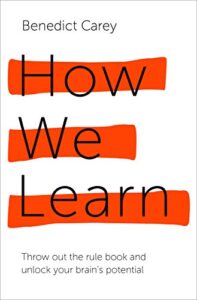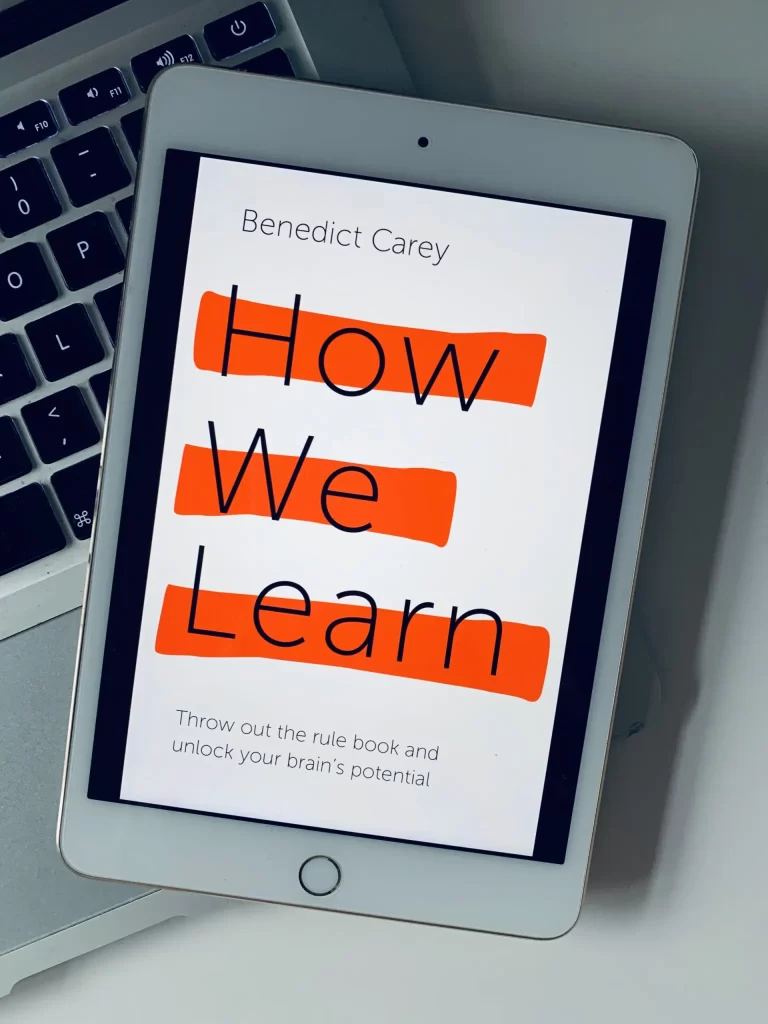 How We Learn. Book Summary
How We Learn. Book Summary
The Surprising Truth About When, Where and Why It Happens
Benedict Carey
Bluebird; Main Market edition (11 Sept. 2014)
About the author
Benedict Carey is a former science reporter for The Times. He was also a health and medical writer for The Los Angeles Times, a freelance journalist and a staff writer for Health magazine.
He has written three books: “How We Learn” (2014), about the cognitive science of learning, and “Poison Most Vial” (2011) and “Island of the Unknowns” (2009), science mysteries for middle schoolers.
Mr. Carey graduated from the University of Colorado with a mathematics degree in 1983. In 1985 he completed a one-year journalism program at Northwestern University.
About the book:
“The treasure at the end of this rainbow is not necessarily ‘brilliance.’ Brilliance is a fine aspiration, and Godspeed to those who have the genes, drive, luck, and connections to win that lottery. But shooting for a goal so vague puts a person at risk of worshipping an ideal—and missing the target. No, this book is about something that is, at once, more humble and more grand: How to integrate the exotica of new subjects into daily life, in a way that makes them seep under our skin. How to make learning more a part of living and less an isolated chore. We will mine the latest science to unearth the tools necessary to pull this off, and to do so without feeling buried or oppressed. And we will show that some of what we’ve been taught to think of as our worst enemies—laziness, ignorance, distraction—can also work in our favor.”
Benedict Carey writes on medical and science topics for The New York Times. In his book How We Learn, he investigates the science behind…how we learn!
After reading Thinking, Fast and Slow by Daniel Kahneman, this book was on my list to dive deeper into the science of memory and learning.
It is an insightful read, full of surprising ideas on how to get the most out of studying and training. In the book, Carey draws on recent research to challenge the conventional approach to learning. Most importantly, he provides counterintuitive advice on how we can all change our study habits and improve performance.
Whether you are an educator, parent or student, I’m sure you’d enjoy reading this book as much as I did.
I wish I had read it when I was at the university!
I’ll share just a few of my favourite ideas in these notes, so grab the book for more!
Let’s dive in.
Key insights:
To master a skill, change the environment
“This research says, take the trunk out of the room. Since we cannot predict the context in which we’ll have to perform, we’re better off varying the circumstances in which we prepare. We need to handle life’s pop quizzes, its spontaneous pickup games and jam sessions, and the traditional advice to establish a strict practice routine is no way to do so. On the contrary: Try another room altogether. Another time of day. Take the guitar outside, into the park, into the woods. Change cafés. Switch practice courts. Put on blues instead of classical. Each alteration of the routine further enriches the skills being rehearsed, making them sharper and more accessible for a longer period of time. This kind of experimenting itself reinforces learning, and makes what you know increasingly independent of your surroundings.”
In the book, Carey provides an excellent overview of how our memory works. He shares a bunch of studies that prove that we can better recall the information when we study in the same environment as where we are tested (e.g. this experiment where people studied and then been tested in two different environments: on land and underwater, or a study where scientists investigated how background music during studying and testing affects performance). In short, the environment has a significant impact on our performance.
That is because, simply speaking, our brain uses the cues in the environment to retrieve information from our memory (our system 1 in action). But the trick here is that if we practice in various settings with many different stimuli, our brain will make more connections so we can retrieve the information better in very different circumstances.
The bottom line: More connections in more places means better recall.
P.S.: years ago, when I was still in school, I used to have a lucky “exam outfit”. It didn’t always help, but I guess that’s because I had to study in it as well ☺
Distributed learning and spacing effect
“People learn at least as much, and retain it much longer, when they distribute—or “space”—their study time than when they concentrate it. Mom’s right, it is better to do a little today and a little tomorrow rather than everything at once. Not just better, a lot better. Distributed learning, in certain situations, can double the amount we remember later on.”
Here is the thing. If you want just to pass the test and forget the information, then cramming the night before the test can work. But if your goal is to learn and remember the information in the long run, then you need a different strategy – distributed learning (aka spaced learning).
The idea is simple: if you have to study for 3 hours, you’d be better off splitting them into three 1-hour chunks spread over a few days than studying for 3 hours straight in one go.
That is because these breaks give your brain a chance to forget a bit of what you learned before, so in the following study session, you need to work a bit harder to retrieve this information. And it thickens the synapses between the neurones of your original memory, thus strengthening it and making the information stick. Here is how you can use it:
“If the test is in a week, and you want to split your study time in two, then do a session today and tomorrow, or today and the day after tomorrow. If you want to add a third, study the day before the test (just under a week later). If the test is a month away, then the best option is today, a week from today (for two sessions); for a third, wait three more weeks or so, until a day before the test. The further away the exam—that is, the more the time you have to prepare—the larger the optimal interval between sessions one and two. That optimal first interval declines as a proportion of the time-to-test, the Internet study found.”
The fluency illusion
“Let’s recall the Bjorks’ ‘desirable difficulty’ principle: The harder your brain has to work to dig out a memory, the greater the increase in learning (retrieval and storage strength). Fluency, then, is the flipside of the equation. The easier it is to call a fact to mind, the smaller the increase in learning. Repeating facts right after you studied them gives you nothing, no added memory benefit.
The fluency illusion is the primary culprit in below-average test performances. Not anxiety. Not stupidity. Not unfairness or bad luck.
Fluency.
The best way to overcome this illusion and improve our testing skills is, conveniently, an effective study technique in its own right. […]
The technique is testing itself. Yes, I am aware of how circular this logic appears: better testing through testing. Don’t be fooled. There’s more to self-examination than you know. A test is not only a measurement tool, it alters what we remember and changes how we subsequently organize that knowledge in our minds. And it does so in ways that greatly improve later performance.”
The fluency illusion is a big cognitive trap.
That’s when you are preparing for a test and go, “yep, that’s easy, got it,” and then your mind goes completely blank when you have to perform.
The antidote? Self-testing! To learn better, always test yourself on what you’ve just studied. Add the spaced learning, and you’ll rock.
Another way to dispel the fluency illusion? Teaching others! By explaining to other people what you’ve just learned, you organize the knowledge in your brain and cement it into your memory.
P.S.: my 7-year-old often complains that math at school is too easy for him, that he knows everything already and doesn’t see the point of doing homework. And that’s when I often offer him to play a multiplication table game, so he has to recall the facts as quickly as possible – his fluency bubble pops, and I have a bit more influence to persuade him to study.
Distract yourself to solve a problem
“For math or spatial problems, like the Pencil Problem, people benefit from any of these three; it doesn’t seem to matter which you choose. For linguistic problems like RAT puzzles or anagrams, on the other hand, breaks consisting of mild activity—videogames, solitaire, TV—seem to work best. Sio and Ormerod found that longer incubation periods were better than short ones, although “long” in this world means about twenty minutes and “short” closer to five minutes—a narrow range determined by nothing more than the arbitrary choices of researchers. They also emphasized that people don’t benefit from an incubation break unless they have reached an impasse. Their definition of “impasse” is not precise, but most of us know the difference between a speed bump and a brick wall. Here’s what matters: Knock off and play a videogame too soon and you get nothing.”
When you are, for example, working on a problem that requires a creative solution or writing a paper, distractions can lead to a-ha! moments and insights. Scientists call it “incubation breaks.” Once your brain is in the incubating period, it is very sensitive to any information in the environment that might be relevant to a solution.
The trick here is to find a sweet spot for a break to reap the benefits.
P.S.: Have you ever heard of dream incubation? Our brain works hard when we sleep (more on that later) – check out our notes on The Molecule of More, where Daniel Lieberman and Michael Long talk about how we can use the power of dream incubation to solve problems (fascinating stuff).
Quitting before you are ahead (Zeigarnik effect)
“When we think about goals, we tend to think in terms of dreams. Restoring a classic car. Living abroad. Starting a business. Writing a novel. Running a marathon. Being a better dad. Finding a stable relationship. For psychologists, however, a goal isn’t nearly so grand. A goal is anything we want to possess or achieve and haven’t yet, whether it’s short-term or long-term, getting a Ph.D. or getting dressed. According to that definition, our heads are full of goals every waking minute, and they’re all competing for our attention. Should we walk the dog, or make coffee first? Help Junior pack for camp, or catch up on some work? Go to the gym, or practice Spanish? Zeigarnik’s studies on interruption revealed a couple of the mind’s intrinsic biases, or built-in instincts, when it comes to goals. The first is that the act of starting work on an assignment often gives that job the psychological weight of a goal, even if it’s meaningless. (The people in her studies were doing things like sculpting a dog from a lump of clay, for heaven’s sake; they got nothing out of it but the satisfaction of finishing.) The second is that interrupting yourself when absorbed in an assignment extends its life in memory and—according to her experiments—pushes it to the top of your mental to-do list.”
Well, sometimes procrastination is not bad at all!
In psychology, the Zeigarnik Effect occurs when an activity that has been interrupted may be more readily recalled. In other words, we remember unfinished or interrupted tasks better than completed tasks. What is also interesting is that being interrupted at the “worst” time seemed to extend memory the longest!
So…use it to learn better. For example, instead of trying to finish an assignment in one go a night before the deadline, start early – even if that’s just simply creating an empty file and saving it with the assignment name. And then progress step by step. I do that often when I’m writing book notes ☺
P.S.: Adam Alter in Irresistible shows how many big companies use the Zeiganik effect to keep our attention – check out our notes for more! In The Molecule of More, the authors also investigate the Zeigarnik effect from the point of view of how dopamine works – fascinating!
Mix it up
“It’s not that repetitive practice is bad. We all need a certain amount of it to become familiar with any new skill or material. But repetition creates a powerful illusion. Skills improve quickly and then plateau. By contrast, varied practice produces a slower apparent rate of improvement in each single practice session but a greater accumulation of skill and learning over time. In the long term, repeated practice on one skill slows us down.”
Repetitive practice feels good as it creates an illusion that we are good at the skill we are practicing. But drilling the same skill over and over again is a “naïve practice” as Anders Ericsson puts it in Peak. And science shows that it’s not very effective for mastering a skill.
So if we really want to improve a particular skill, we need a different type of practice – a varied practice. In the book, Carey brings up a few studies that clearly demonstrate that we perform much better when practising different skills at the same time, rather than doing a “blocked” or “massed” practice. Cognitive scientists call it INTERLEAVING.
Here is an example of one study. The researchers brought into a lab two groups of kids. The first group practised throwing a bean bag into a bucket 3 feet away. The second group practised throwing into buckets both 2 and 4 feet away, but never 3 feet. Then, the next day, the researchers mixed the groups, and the children had a competition throwing bean bags into a bucket 3 feet away. Guess which children did better? You’d think the kids that’s been practising on the 3 feet target nailed it, but surprisingly those who varied their practice (the second group) did the best!
Carey also writes:
“Mixing problems during study forces us to identify each type of problem and match it to the appropriate kind of solution. We are not only discriminating between the locks to be cracked; we are connecting each lock with the right key.”
So if you want to learn a new skill – whether in sports, playing music, or solving maths problems – vary your practice. Mix it up!
P.S.: our kids study French on Duolingo – and I absolutely love how they use cognitive science to help people learn foreign languages! Definitely check it out if learning a new language is on your list!
Sleep to boost learning.
“I’ve always loved my sleep, but in the context of learning I assumed it was getting in the way. Not so. The latest research says exactly the opposite: that unconscious downtime clarifies memory and sharpens skills—that it’s a necessary step to lock in both. In a fundamental sense, that is, sleep is learning.”
Sleep is essential for our brain to form and consolidate new memories. So getting enough sleep is super important for effective learning.
In the book, Carey walks us through the processes in our brain during different stages of sleep and shares fascinating insights on how you can alter your studying strategy based on your sleep stage – check out the book for more.
And guess what? Naps are great for boosting learning as well:
“Napping is sleep, too. In a series of experiments over the past decade, Sara Mednick of the University of California, San Diego, has found that naps of an hour to an hour and half often contain slow-wave deep sleep and REM. People who study in the morning—whether it’s words or pattern recognition games, straight retention or comprehension of deeper structure—do about 30 percent better on an evening test if they’ve had an hour-long nap than if they didn’t. ‘It’s changed the way I work, doing these studies,’ Mednick told me. ‘It’s changed the way I live. With naps of an hour to an hour and half, we’ve found in some experiments that you get close to the same benefits in learning consolidation that you would from a full eight-hour night’s sleep.’”
Andrew Huberman, one of the most influential neuroscientists, advocates Non-Sleep Deep Rest Practice (NSDR or Yoga Nidra) to boost learning and motivation. Now it’s my number one strategy after a poor night of sleep or when I need to concentrate on finishing some writing before the kids return from school.
Action steps for you:
- When learning new information or studying for an exam, use the three most effective strategies: distributed learning, self-testing and explaining the material to someone (teaching).
- Vary your practice – don’t drill one skill. Mix it up with other skills to improve your learning and performance.
- Have a good night of sleep before a test or any other important performance where you rely on your memory. Naps are also effective breaks that boost learning.
Quotes from the book:









